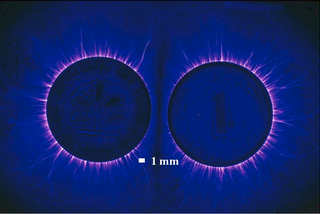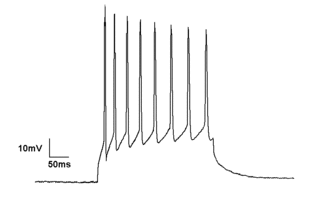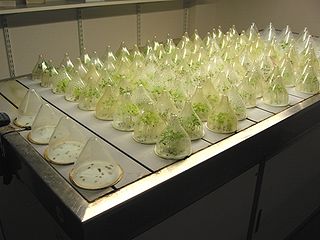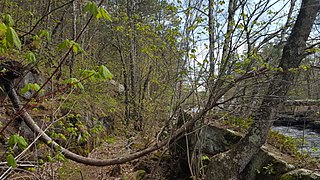Related Research Articles

An electric current is a flow of charged particles, such as electrons or ions, moving through an electrical conductor or space. It is defined as the net rate of flow of electric charge through a surface. The moving particles are called charge carriers, which may be one of several types of particles, depending on the conductor. In electric circuits the charge carriers are often electrons moving through a wire. In semiconductors they can be electrons or holes. In an electrolyte the charge carriers are ions, while in plasma, an ionized gas, they are ions and electrons.

Electricity is the set of physical phenomena associated with the presence and motion of matter that has a property of electric charge. Electricity is related to magnetism, both being part of the phenomenon of electromagnetism, as described by Maxwell's equations. Various common phenomena are related to electricity, including lightning, static electricity, electric heating, electric discharges and many others.

Electric charge is the physical property of matter that causes it to experience a force when placed in an electromagnetic field. Electric charge can be positive or negative. Like charges repel each other and unlike charges attract each other. An object with no net charge is referred to as electrically neutral. Early knowledge of how charged substances interact is now called classical electrodynamics, and is still accurate for problems that do not require consideration of quantum effects.

Kirlian photography is a collection of photographic techniques used to capture the phenomenon of electrical coronal discharges. It is named after Semyon Kirlian, who, in 1939, accidentally discovered that if an object on a photographic plate is connected to a high-voltage source, an image is produced on the photographic plate. The technique has been variously known as "electrography", "electrophotography", "corona discharge photography" (CDP), "bioelectrography", "gas discharge visualization (GDV)", "electrophotonic imaging (EPI)", and, in Russian literature, "Kirlianography".

In vascular plants, the roots are the organs of a plant that are modified to provide anchorage for the plant and take in water and nutrients into the plant body, which allows plants to grow taller and faster. They are most often below the surface of the soil, but roots can also be aerial or aerating, that is, growing up above the ground or especially above water.

Electrophysiology is the branch of physiology that studies the electrical properties of biological cells and tissues. It involves measurements of voltage changes or electric current or manipulations on a wide variety of scales from single ion channel proteins to whole organs like the heart. In neuroscience, it includes measurements of the electrical activity of neurons, and, in particular, action potential activity. Recordings of large-scale electric signals from the nervous system, such as electroencephalography, may also be referred to as electrophysiological recordings. They are useful for electrodiagnosis and monitoring.

Plant nutrition is the study of the chemical elements and compounds necessary for plant growth and reproduction, plant metabolism and their external supply. In its absence the plant is unable to complete a normal life cycle, or that the element is part of some essential plant constituent or metabolite. This is in accordance with Justus von Liebig’s law of the minimum. The total essential plant nutrients include seventeen different elements: carbon, oxygen and hydrogen which are absorbed from the air, whereas other nutrients including nitrogen are typically obtained from the soil.

Plant physiology is a subdiscipline of botany concerned with the functioning, or physiology, of plants. Closely related fields include plant morphology, plant ecology, phytochemistry, cell biology, genetics, biophysics and molecular biology.

Phytochromes are a class of photoreceptor in plants, bacteria and fungi used to detect light. They are sensitive to light in the red and far-red region of the visible spectrum and can be classed as either Type I, which are activated by far-red light, or Type II that are activated by red light. Recent advances have suggested that phytochromes also act as temperature sensors, as warmer temperatures enhance their de-activation. All of these factors contribute to the plant's ability to germinate.

Gravitropism is a coordinated process of differential growth by a plant in response to gravity pulling on it. It also occurs in fungi. Gravity can be either "artificial gravity" or natural gravity. It is a general feature of all higher and many lower plants as well as other organisms. Charles Darwin was one of the first to scientifically document that roots show positive gravitropism and stems show negative gravitropism. That is, roots grow in the direction of gravitational pull and stems grow in the opposite direction. This behavior can be easily demonstrated with any potted plant. When laid onto its side, the growing parts of the stem begin to display negative gravitropism, growing upwards. Herbaceous (non-woody) stems are capable of a degree of actual bending, but most of the redirected movement occurs as a consequence of root or stem growth outside. The mechanism is based on the Cholodny–Went model which was proposed in 1927, and has since been modified. Although the model has been criticized and continues to be refined, it has largely stood the test of time.
In developmental biology, photomorphogenesis is light-mediated development, where plant growth patterns respond to the light spectrum. This is a completely separate process from photosynthesis where light is used as a source of energy. Phytochromes, cryptochromes, and phototropins are photochromic sensory receptors that restrict the photomorphogenic effect of light to the UV-A, UV-B, blue, and red portions of the electromagnetic spectrum.

Etiolation is a process in flowering plants grown in partial or complete absence of light. It is characterized by long, weak stems; smaller leaves due to longer internodes; and a pale yellow color (chlorosis). The development of seedlings in the dark is known as "skotomorphogenesis" and leads to etiolated seedlings.

Lunar soil is the fine fraction of lunar regolith found on the surface of the Moon and contributes to the Moon's tenuous atmosphere. Lunar soil differs in its origin and properties significantly from terrestrial soil.

Selaginella apoda, commonly known as meadow spikemoss, is a perennial lycophyte native to much of the eastern United States and parts of northeastern Mexico. The life cycle is the shortest of the genus Selaginella, as well as one of the shortest among the lycophytes. Selaginella apoda is found primarily in damp soils in habitats such as swamps, wet fields, open woods and along stream banks. Selaginella apoda presents the potential for case studies involving the plant's adaptability to environmental toxins. A lowland plant, it has only been recorded at elevations below 100 meters. It is closely related to Selaginella eclipes and S. ludoviciana, with both of which it has been reported to form hybrids. This group is characterized by relatively flat strobili and large megasporophylls which occur in the same plane as the lateral leaves.

A glass stirring rod, glass rod, stirring rod or stir rod is a piece of laboratory equipment used to mix chemicals. They are usually made of solid glass, about the thickness and slightly longer than a drinking straw, with rounded ends.

In biology, phototropism is the growth of an organism in response to a light stimulus. Phototropism is most often observed in plants, but can also occur in other organisms such as fungi. The cells on the plant that are farthest from the light contain a hormone called auxin that reacts when phototropism occurs. This causes the plant to have elongated cells on the furthest side from the light. Phototropism is one of the many plant tropisms, or movements, which respond to external stimuli. Growth towards a light source is called positive phototropism, while growth away from light is called negative phototropism. Negative phototropism is not to be confused with skototropism, which is defined as the growth towards darkness, whereas negative phototropism can refer to either the growth away from a light source or towards the darkness. Most plant shoots exhibit positive phototropism, and rearrange their chloroplasts in the leaves to maximize photosynthetic energy and promote growth. Some vine shoot tips exhibit negative phototropism, which allows them to grow towards dark, solid objects and climb them. The combination of phototropism and gravitropism allow plants to grow in the correct direction.

Ruth Lyttle Satter was an American botanist best known for her work on circadian leaf movement.
Takuma Akuma Tanada was an American plant biologist who made several discoveries related to the effects of light radiation on plants, including his discovery of the Tanada effect. He conducted research at the United States Department of Agriculture and in 2011 was awarded a Congressional Gold Medal, the highest civilian award in the United States, for his assistance to the U.S. military in World War II.
Electroreflectance is the change of reflectivity of a solid due to the influence of an electric field close to, or at the interface of the solid with a liquid. The change in reflectivity is most noticeable at very specific ranges of photon energy, corresponding to the band gaps at critical points of the Brillouin zone.